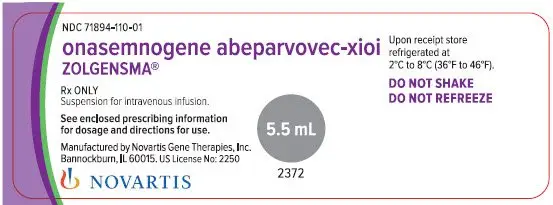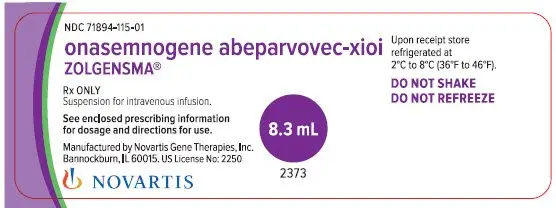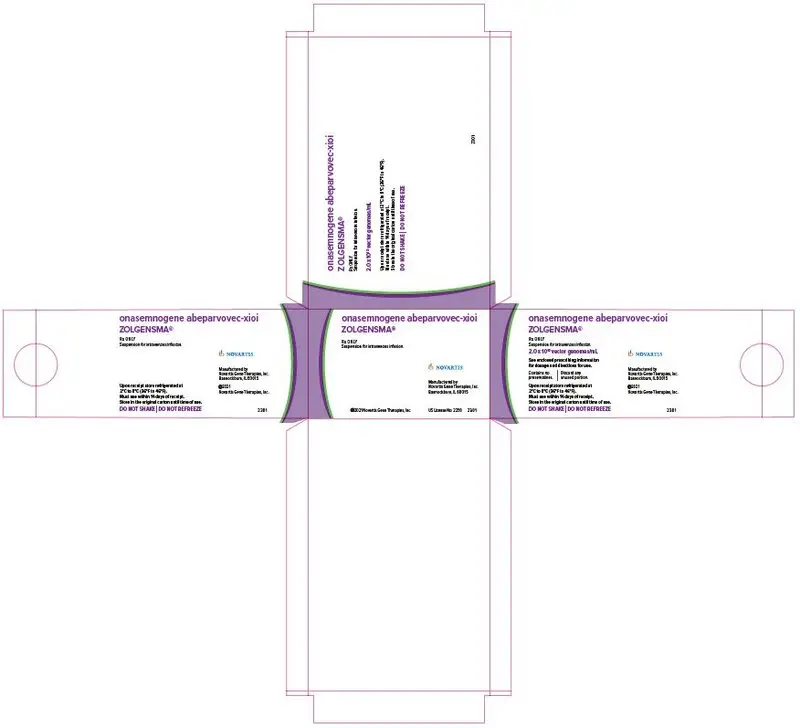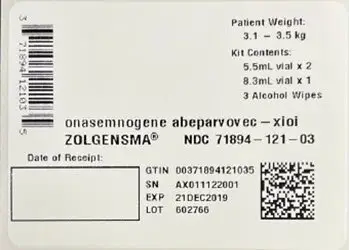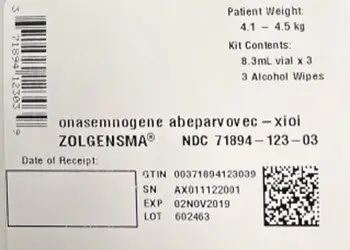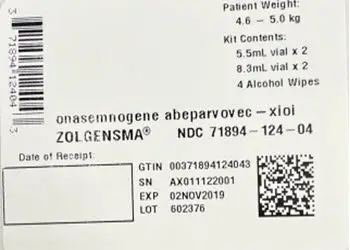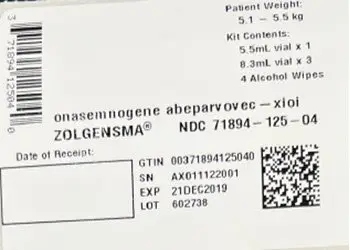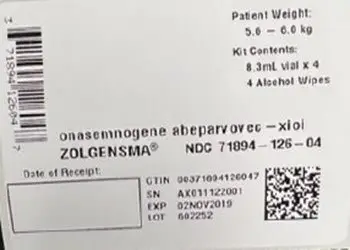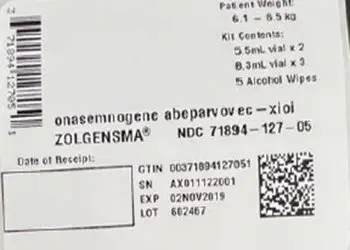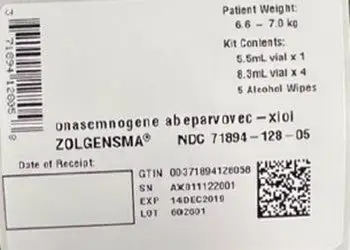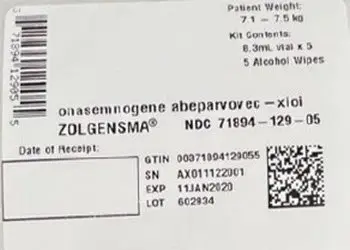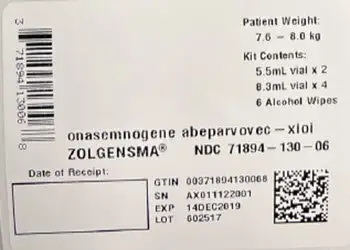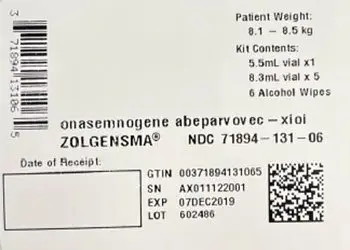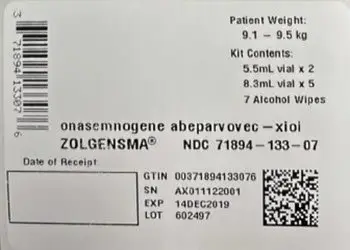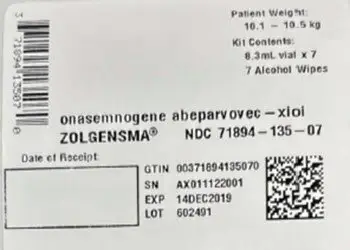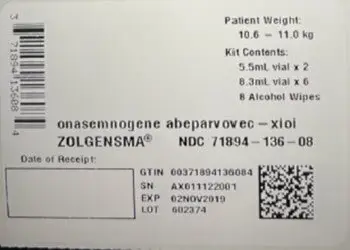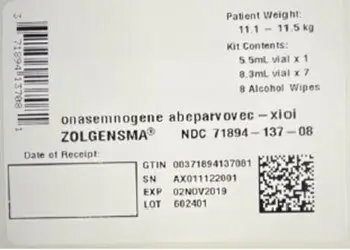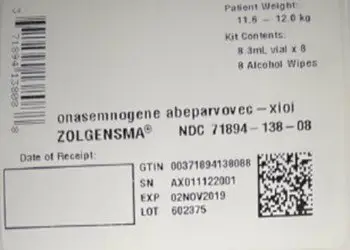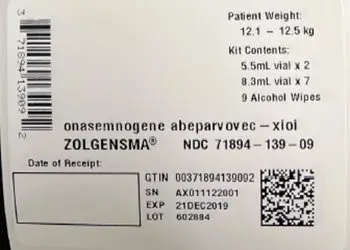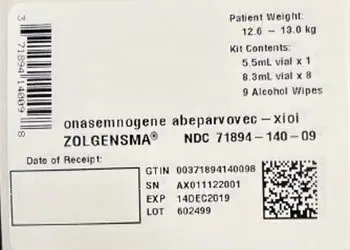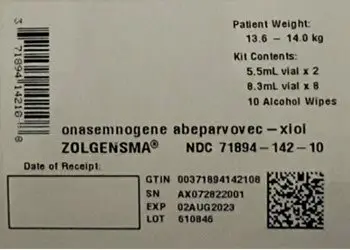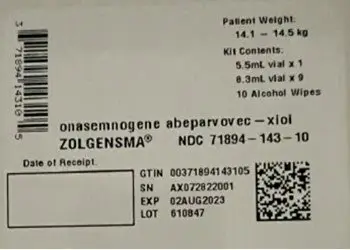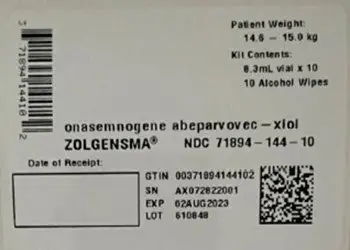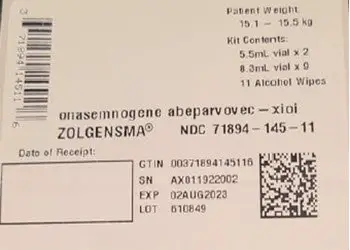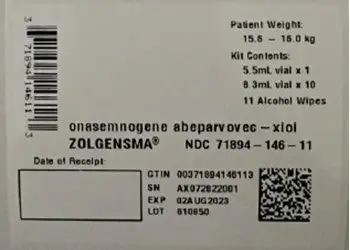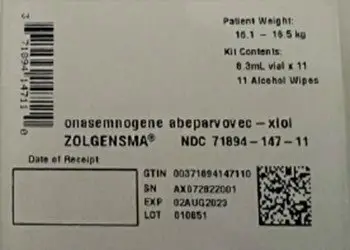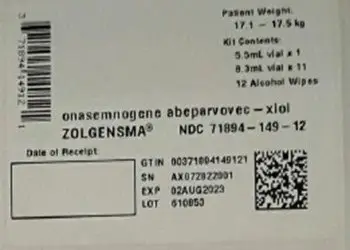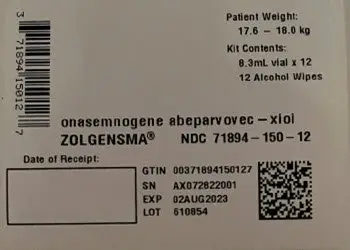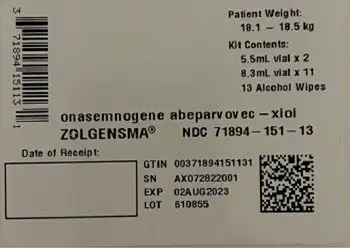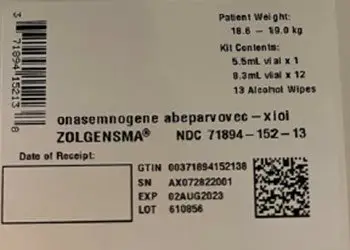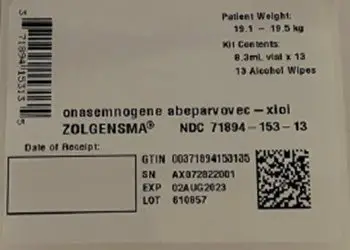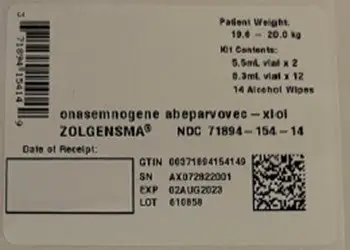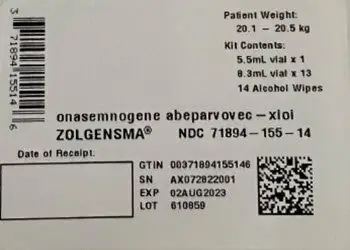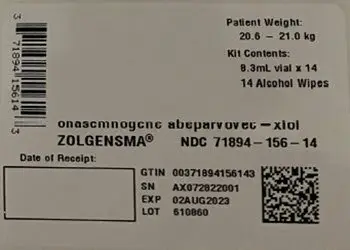Drug Detail:Zolgensma (Onasemnogene abeparvovec-xioi)
Drug Class: Miscellaneous uncategorized agents
Highlights of Prescribing Information
ZOLGENSMA® (onasemnogene abeparvovec-xioi) suspension, for intravenous infusion
Initial U.S. Approval: 2019
WARNING: SERIOUS LIVER INJURY AND ACUTE LIVER FAILURE
See full prescribing information for complete boxed warning.
- Cases of acute liver failure with fatal outcomes have been reported. Acute serious liver injury and elevated aminotransferases can also occur with ZOLGENSMA. (5.1)
- Patients with preexisting liver impairment may be at higher risk. (5.1)
- Prior to infusion, assess liver function of all patients by clinical examination and laboratory testing. Administer systemic corticosteroid to all patients before and after ZOLGENSMA infusion. Continue to monitor liver function for at least 3 months after infusion, and at other times as clinically indicated. (2.1, 2.3)
Recent Major Changes
| Boxed Warning | 2/2023 |
| Dosage and Administration (2.1, 2.3) | 2/2023 |
| Dosage and Administration (2.2) | 11/2022 |
| Warnings and Precautions (5.1, 5.2, 5.3, 5.4) | 2/2023 |
Indications and Usage for Zolgensma
ZOLGENSMA is an adeno-associated virus vector-based gene therapy indicated for the treatment of pediatric patients less than 2 years of age with spinal muscular atrophy (SMA) with bi-allelic mutations in the survival motor neuron 1 (SMN1) gene. (1)
Limitations of Use
- The safety and effectiveness of repeat administration of ZOLGENSMA have not been evaluated. (1, 6.2)
- The use of ZOLGENSMA in patients with advanced SMA (e.g., complete paralysis of limbs, permanent ventilator dependence) has not been evaluated. (1, 14)
Zolgensma Dosage and Administration
ZOLGENSMA is for single-dose intravenous infusion only (2).
- The recommended dosage of ZOLGENSMA is 1.1 × 1014 vector genomes (vg) per kg of body weight. (2.1)
- Administer ZOLGENSMA as an intravenous infusion over 60 minutes. (2.1, 2.3)
- Postpone ZOLGENSMA in patients with infections until the infection has resolved and the patient is clinically stable. Clinical signs or symptoms of infection should not be evident at the time of ZOLGENSMA infusion. (2.1, 5.2)
- Starting one day prior to ZOLGENSMA infusion, administer systemic corticosteroids equivalent to oral prednisolone at 1 mg/kg of body weight per day for a total of 30 days. (2.1)
- At the end of the 30-day period of systemic corticosteroid treatment, check liver function by clinical examination and by laboratory testing. For patients with unremarkable findings, taper the corticosteroid dose gradually over the next 28 days. If liver function abnormalities persist, continue systemic corticosteroids (equivalent to oral prednisolone at 1 mg/kg/day) until findings become unremarkable, and then taper the corticosteroid dose gradually over the next 28 days or longer if needed. Do not stop systemic corticosteroids abruptly. (2.1)
- If liver function abnormalities continue to persist ≥ 2 × ULN after the 30-day period of systemic corticosteroids, promptly consult a pediatric gastroenterologist or hepatologist. (2.1)
Dosage Forms and Strengths
ZOLGENSMA is a suspension for intravenous infusion, supplied as single-use vials. (3)
ZOLGENSMA is provided in a kit containing 2 to 14 vials, as a combination of 2 vial fill volumes (either 5.5 mL or 8.3 mL). All vials have a nominal concentration of 2.0 × 1013 vector genomes (vg) per mL. Each vial of ZOLGENSMA contains an extractable volume of not less than either 5.5 mL or 8.3 mL. (3)
Contraindications
None. (4)
Warnings and Precautions
- Systemic Immune Response: Administer ZOLGENSMA to patients who are clinically stable in their overall baseline health status (e.g., hydration and nutritional status, absence of infection) prior to infusion. (5.2)
- Thrombocytopenia: Monitor platelet counts before ZOLGENSMA infusion, and at least weekly for the first month and then every other week for the second and third month or until platelet counts return to baseline. (2.3, 5.3)
- Thrombotic Microangiopathy (TMA): Prompt attention to signs and symptoms of TMA is advised, as TMA can result in life-threatening or fatal outcomes. If clinical signs, symptoms and/or laboratory findings occur, consult a pediatric hematologist and/or pediatric nephrologist immediately to manage as clinically indicated. (5.4)
- Elevated Troponin-I: Monitor troponin-I before ZOLGENSMA infusion, and weekly for the first month and then monthly for the second and third month until troponin-I level returns to baseline. (2.3, 5.5)
Adverse Reactions/Side Effects
The most common adverse reactions (incidence ≥ 5%) were elevated aminotransferases and vomiting. (6)
To report SUSPECTED ADVERSE REACTIONS, contact Novartis Gene Therapies at 1-833-828-3947 or FDA at 1-800-FDA-1088 or www.fda.gov/medwatch.
Drug Interactions
Where feasible, adjust a patient’s vaccination schedule to accommodate concomitant corticosteroid administration prior to and following ZOLGENSMA infusion. (7)
Use In Specific Populations
Pediatric Use: Use of ZOLGENSMA in premature neonates before reaching full term gestational age is not recommended because concomitant treatment with corticosteroids may adversely affect neurological development. Delay ZOLGENSMA infusion until full-term gestational age is reached. (8.4)
See 17 for PATIENT COUNSELING INFORMATION.
Revised: 2/2023
Related/similar drugs
Evrysdi, nusinersen, Spinraza, risdiplamFull Prescribing Information
1. Indications and Usage for Zolgensma
ZOLGENSMA is an adeno-associated virus vector-based gene therapy indicated for the treatment of pediatric patients less than 2 years of age with spinal muscular atrophy (SMA) with bi-allelic mutations in the survival motor neuron 1 (SMN1) gene.
Limitations of Use
- The safety and effectiveness of repeat administration of ZOLGENSMA have not been evaluated [see Adverse Reactions (6.2)].
- The use of ZOLGENSMA in patients with advanced SMA (e.g., complete paralysis of limbs, permanent ventilator-dependence) has not been evaluated [see Clinical Studies (14)].
2. Zolgensma Dosage and Administration
For single-dose intravenous infusion only.
2.1 Dose and Administration
The recommended dose of ZOLGENSMA is 1.1 × 1014 vector genomes per kilogram (vg/kg) of body weight.
| Patient weight range (kg) | Dose volumea (mL) |
|---|---|
| aDose volume is calculated using the upper limit of the patient weight range for pediatric patients less than 2 years of age between 2.6 kg and 21.0 kg. | |
|
2.6 – 3.0 |
16.5 |
|
3.1 – 3.5 |
19.3 |
|
3.6 – 4.0 |
22.0 |
|
4.1 – 4.5 |
24.8 |
|
4.6 – 5.0 |
27.5 |
|
5.1 – 5.5 |
30.3 |
|
5.6 – 6.0 |
33.0 |
|
6.1 – 6.5 |
35.8 |
|
6.6 – 7.0 |
38.5 |
|
7.1 – 7.5 |
41.3 |
|
7.6 – 8.0 |
44.0 |
|
8.1 – 8.5 |
46.8 |
|
8.6 – 9.0 |
49.5 |
|
9.1 – 9.5 |
52.3 |
|
9.6 – 10.0 |
55.0 |
|
10.1 – 10.5 |
57.8 |
|
10.6 – 11.0 |
60.5 |
|
11.1 – 11.5 |
63.3 |
|
11.6 – 12.0 |
66.0 |
|
12.1 – 12.5 |
68.8 |
|
12.6 – 13.0 |
71.5 |
|
13.1 – 13.5 |
74.3 |
|
13.6 – 14.0 |
77.0 |
|
14.1 – 14.5 |
79.8 |
|
14.6 – 15.0 |
82.5 |
|
15.1 – 15.5 |
85.3 |
|
15.6 – 16.0 |
88.0 |
|
16.1 – 16.5 |
90.8 |
|
16.6 – 17.0 |
93.5 |
|
17.1 – 17.5 |
96.3 |
|
17.6 – 18.0 |
99.0 |
|
18.1 – 18.5 |
101.8 |
|
18.6 – 19.0 |
104.5 |
|
19.1 – 19.5 |
107.3 |
|
19.6 – 20.0 |
110.0 |
|
20.1 – 20.5 |
112.8 |
|
20.6 – 21.0 |
115.5 |
- Prior to ZOLGENSMA infusion:
- Due to the increased risk of serious systemic immune response, administer ZOLGENSMA to patients who are clinically stable in their overall baseline health status (e.g., hydration and nutritional status, absence of infection) prior to infusion. Postpone ZOLGENSMA in patients with infections until the infection has resolved and the patient is clinically stable. Clinical signs or symptoms of infection should not be evident at the time of ZOLGENSMA infusion [see Warnings and Precautions (5.2, 5.4), Patient Counseling Information (17)].
- Assess liver function [see Boxed Warning, Dosage and Administration (2.3), Warnings and Precautions (5.1), Use in Specific Populations (8.6)].
- Obtain creatinine, complete blood count (including hemoglobin and platelet count), and troponin-I [see Dosage and Administration (2.3), Warnings and Precautions (5.3, 5.4, 5.5)].
- Perform baseline testing for the presence of anti-AAV9 antibodies [see Dosage and Administration (2.3), Adverse Reactions (6.2)].
- One day prior to ZOLGENSMA infusion, begin administration of systemic corticosteroids equivalent to oral prednisolone at 1 mg per kg of body weight per day (mg/kg/day) for a total of 30 days.
- Administer ZOLGENSMA as a single-dose intravenous infusion through a venous catheter.
Follow the steps below for infusion:
- 1.
- Place a primary catheter into a vein (generally a peripheral vein in the arm or leg). Insertion of a back-up catheter is recommended.
- 2.
- Program syringe pump for saline priming, or prime tubing manually with saline.
- 3.
- Administer ZOLGENSMA as a slow infusion over 60 minutes. DO NOT INFUSE AS AN INTRAVENOUS PUSH OR BOLUS.
- 4.
- Flush line with saline following completion of infusion.
- Monitor liver function by clinical examination and by laboratory testing on a regular basis, and at other times as clinically indicated [see Dosage and Administration (2.3)].
- At the end of the 30-day period of systemic corticosteroid treatment, check liver status clinically and by assessing ALT, AST, total bilirubin, prothrombin time, and INR.
- Promptly assess and closely monitor patients with worsening liver function test results and/or signs or symptoms of acute illness (e.g., vomiting, deterioration in health) [see Warnings and Precautions (5.1)].
- For patients with unremarkable findings (normal clinical exam, total bilirubin, prothrombin time, and INR and ALT and AST levels below 2 × upper limit of normal [ULN]): Taper the corticosteroid dose gradually over the next 28 days. Do not stop systemic corticosteroids abruptly [see Warnings and Precautions (5.1)].
- If liver function abnormalities persist, continue systemic corticosteroids (equivalent to oral prednisolone at 1 mg/kg/day) until AST and ALT values are both below 2 × ULN and all other assessments return to normal range, and then taper the corticosteroid dose gradually over the next 28 days or longer if needed. Do not stop systemic corticosteroids abruptly [see Warnings and Precautions (5.1)].
- If liver function abnormalities continue to persist ≥ 2 × ULN after the 30-day period of systemic corticosteroids, promptly consult a pediatric gastroenterologist or hepatologist [see Warnings and Precautions (5.1)].
- If oral corticosteroid therapy is not tolerated, consider intravenous corticosteroids as clinically indicated [see Warnings and Precautions (5.1)].
2.2 Preparation
- Thaw ZOLGENSMA before use. The contents of the ZOLGENSMA kit will thaw in approximately 16 hours if placed in a refrigerator, or in approximately 6 hours if placed at room temperature. If thawed in a refrigerator, remove from refrigerator on day of dosing.
- When thawed, ZOLGENSMA is a clear to slightly opaque, colorless to faint white liquid, free of particles. Visually inspect vials for particulate matter and discoloration prior to infusion. Do not use vials if particulates or discoloration are present.
- DO NOT SHAKE.
- Draw the appropriate dose volume from all vials into a syringe, remove air from the syringe, cap the syringe, and deliver the syringe at room temperature to the patient infusion location.
- Use ZOLGENSMA within 8 hours of drawing into syringe. Discard the vector-containing syringe if the drug is not infused within the 8-hour timeframe.
- DO NOT REFREEZE.
2.3 Laboratory Testing and Monitoring to Assess Safety
Perform baseline anti-AAV9 antibody testing prior to ZOLGENSMA infusion. Retesting may be performed if anti-AAV9 antibody titers are reported as > 1:50 [see Dosage and Administration (2.1)].
Conduct the following tests at baseline and as directed below [see Warnings and Precautions (5.1, 5.3, 5.5)]:
- Liver function (clinical exam, AST, ALT, total bilirubin, albumin, prothrombin time, partial thromboplastin time [PTT], and international normalized ratio [INR]) at baseline. Monitor liver function (AST, ALT, total bilirubin, prothrombin time, INR) weekly for the first month after ZOLGENSMA infusion and during the corticosteroid taper period (28 days or longer if needed). If the patient is clinically stable with unremarkable findings (normal clinical exam, total bilirubin, and prothrombin and INR results, and ALT and AST levels below 2 × ULN) at the end of the corticosteroid taper period, continue to monitor liver function every other week for another month.
- Platelet counts weekly for the first month, and then every other week for the second and third months, until platelet counts return to baseline.
- Troponin-I weekly for the first month, and then monthly for the second and third months, until troponin-I level returns to baseline.
3. Dosage Forms and Strengths
ZOLGENSMA is a suspension for intravenous infusion.
ZOLGENSMA is provided in a kit containing 2 to 14 vials. Vials are provided in 2 fill volumes: 5.5 mL or 8.3 mL.
ZOLGENSMA has a nominal concentration of 2.0 × 1013 vg/mL, and each vial contains an extractable volume of not less than either 5.5 mL or 8.3 mL.
The intravenous dosage is determined by patient body weight, with a recommended dose of 1.1 × 1014 vg/kg for pediatric patients.
5. Warnings and Precautions
5.1 Acute Serious Liver Injury, Acute Liver Failure or Elevated Aminotransferases
Acute serious liver injury, acute liver failure and elevated aminotransferases can occur with ZOLGENSMA. Hepatotoxicity (which may be immune-mediated), generally manifested as elevated ALT and/or AST levels. Acute serious liver injury and acute liver failure, including fatal cases, have been reported with ZOLGENSMA use [see Adverse Reactions (6)]. In order to mitigate potential aminotransferase elevations, administer systemic corticosteroid to all patients before and after ZOLGENSMA infusion. Immune-mediated hepatotoxicity may require adjustment of the corticosteroid treatment regimen, including longer duration, increased dose, or prolongation of the corticosteroid taper [see Dosage and Administration (2.1)].
Patients with preexisting liver impairment or acute hepatic viral infection may be at higher risk of acute serious liver injury/acute liver failure. Patients with ALT, AST, or total bilirubin levels (except due to neonatal jaundice) > 2 × ULN have not been studied in clinical trials with ZOLGENSMA. Carefully consider the risks and benefits of ZOLGENSMA therapy in patients with preexisting liver impairment.
Although in the clinical trials and in postmarketing experience, asymptomatic aminotransferase elevations were very commonly reported [see Adverse Reactions (6.1)], in the managed access program and in the postmarketing setting, cases of acute serious liver injury and acute liver failure including a few cases with fatal outcomes, have been reported. Some patients have experienced elevations in ALT and AST > 20 × ULN, prolonged prothrombin time and have been symptomatic (e.g., vomiting, jaundice), which required the use of corticosteroids, sometimes with prolonged duration and/or a higher dose. If acute serious liver injury or acute liver failure is suspected, promptly consult a pediatric gastroenterologist or hepatologist.
Prior to ZOLGENSMA infusion, assess liver function by clinical examination and laboratory testing (hepatic aminotransferases [AST and ALT], total bilirubin level, albumin, prothrombin time, PTT, and INR). Continue to monitor liver function (AST, ALT, total bilirubin, prothrombin time, INR) for at least 3 months after ZOLGENSMA infusion, and at other times as clinically indicated.
Promptly assess and closely monitor patients with worsening liver function test results and/or signs or symptoms of acute illness (e.g., vomiting, deterioration in health). In case hepatic injury is suspected, further testing of albumin, PTT, and INR is recommended.
Monitor liver function weekly for the first month after ZOLGENSMA infusion and during the corticosteroid taper period (28 days or longer if needed). If the patient is clinically stable with unremarkable findings at the end of the corticosteroid taper period, continue to monitor liver function every other week for another month [see Dosage and Administration (2.3)].
5.2 Systemic Immune Response
Due to activation of humoral and cellular immunity following ZOLGENSMA infusion, patients with underlying active infection, either acute (e.g., respiratory, gastrointestinal) or chronic uncontrolled (e.g., chronic active hepatitis B), could be at an increased risk of serious systemic immune response, potentially resulting in more severe clinical courses of the infection. Serious systemic immune response can present with a variety of findings (e.g., high fever, hypotension, etc.). Patients with infection were excluded from participation in ZOLGENSMA clinical trials. Recommend increased vigilance in the prevention, monitoring, and management of infection before and after ZOLGENSMA infusion.
To mitigate the risk of serious and life-threatening systemic immune response, administer ZOLGENSMA to patients who are clinically stable in their overall baseline health status (e.g., hydration and nutritional status, absence of infection) prior to infusion. Postpone ZOLGENSMA in patients with infections until the infection has resolved and the patient is clinically stable. Clinical signs or symptoms of infection should not be evident at the time of ZOLGENSMA infusion [see Dosage and Administration (2.1)]. Recommend seasonal prophylaxis against influenza and respiratory syncytial virus (RSV) and vaccination status should be up-to-date prior to ZOLGENSMA administration.
5.3 Thrombocytopenia
Transient decreases in platelet counts, some of which met the criteria for thrombocytopenia, were typically observed within the first two weeks after ZOLGENSMA infusion.
Monitor platelet counts before ZOLGENSMA infusion and closely monitor platelet counts within the first two weeks following infusion and on a regular basis afterwards (at least weekly for the first month; every other week for the second and third months or until platelet counts return to baseline) [see Dosage and Administration (2.3)].
5.4 Thrombotic Microangiopathy
Cases of thrombotic microangiopathy (TMA) were reported to occur generally within the first two weeks after ZOLGENSMA infusion in the post-marketing setting [see Adverse Reactions (6.3)]. TMA is characterized by thrombocytopenia, microangiopathic hemolytic anemia, and acute kidney injury. Concurrent immune system activation (e.g., infections, vaccinations) was identified in some cases.
Prompt attention to signs and symptoms of TMA is advised, as TMA can result in life-threatening or fatal outcomes.
Monitor platelet counts closely within the first two weeks following infusion and on a regular basis afterwards [see Warnings and Precautions (5.3)], as well as signs and symptoms of TMA, such as hypertension, increased bruising, seizures, or decreased urine output. In case these signs and symptoms occur in the presence of thrombocytopenia, further diagnostic evaluation for hemolytic anemia and renal dysfunction should be promptly undertaken. If clinical signs, symptoms and/or laboratory findings consistent with TMA occur, consult a pediatric hematologist and/or pediatric nephrologist immediately to manage TMA as clinically indicated.
5.5 Elevated Troponin-I
Increases in cardiac troponin-I levels (up to 0.176 mcg/L) were observed following ZOLGENSMA infusion in clinical trials. The clinical importance of these findings is not known. However, cardiac toxicity was observed in animal studies [see Nonclinical Toxicology (13.2)]. Monitor troponin-I before ZOLGENSMA infusion and on a regular basis for at least 3 months afterwards (weekly for the first month, and then monthly for the second and third months until troponin-I level returns to baseline). Consider consultation with a cardiologist, if troponin elevations are accompanied by clinical signs or symptoms (e.g., heart rate changes, cyanosis, tachypnea and respiratory distress) [see Dosage and Administration (2.3)].
6. Adverse Reactions/Side Effects
The most common adverse reactions (incidence ≥ 5%) were elevated aminotransferases and vomiting.
6.1 Clinical Trials Experience
Because clinical trials are conducted under widely varying conditions, adverse reaction rates observed in the clinical trials of a drug cannot be directly compared to rates in the clinical trials of another product and may not reflect the rates observed in practice.
The safety data described in this section reflect exposure to ZOLGENSMA in four open-label studies conducted in the United States, including one completed clinical trial, two ongoing clinical trials, and one ongoing observational long-term follow-up study of the completed trial. A total of 44 patients with SMA received intravenous infusion of ZOLGENSMA, 41 patients at or above the recommended dose, and 3 patients at a lower dose. The patient population ranged in age from 0.3 months to 7.9 months at the time of infusion (weight range 3.0 kg to 8.4 kg).
The most frequent adverse reactions (incidence ≥ 5%) observed in the 4 studies are summarized in Table 2.
| Adverse Reactions | Patients
n (%) |
|---|---|
| Abbreviation: ULN, upper limit of normal. aElevated aminotransferases include elevation of alanine aminotransferase and/or aspartate aminotransferase. bIn the completed clinical trial, one patient (the first patient infused in that study) was enrolled prior to the protocol amendment instituting administration of prednisolone before and after ZOLGENSMA infusion. |
|
|
Elevated aminotransferasesab(> ULN) |
12 (27.3%) |
|
Vomiting |
3 (6.8%) |
One patient in an ongoing non-United States clinical trial initially presented with respiratory insufficiency 12 days after ZOLGENSMA infusion and was found to have RSV and parainfluenza in respiratory secretions. The patient had episodes of serious hypotension, followed by seizures, and was found to have leukoencephalopathy (brain white matter defects) approximately 30 days after ZOLGENSMA infusion. The patient died after withdrawal of life support 52 days after ZOLGENSMA infusion.
6.2 Immunogenicity
In ZOLGENSMA clinical trials, patients were required to have baseline anti-AAV9 antibody titers of ≤ 1:50, measured using an enzyme-linked immunosorbent assay (ELISA). Evidence of prior exposure to AAV9 was uncommon. The safety and efficacy of ZOLGENSMA in patients with anti-AAV9 antibody titers above 1:50 have not been evaluated. Perform baseline testing for the presence of anti-AAV9 antibodies prior to ZOLGENSMA infusion. Retesting may be performed if anti-AAV9 antibody titers are reported as > 1:50 [see Dosage and Administration (2.1, 2.3)].
Following ZOLGENSMA infusion, increases from baseline in anti-AAV9 antibody titers occurred in all patients. In the completed clinical trial, anti-AAV9 antibody titers reached at least 1:102,400 in every patient, and titers exceeded 1:819,200 in most patients. Re-administration of ZOLGENSMA in the presence of high anti-AAV9 antibody titer has not been evaluated.
6.3 Postmarketing Experience
The following adverse reactions have been identified during post-approval use of ZOLGENSMA. Because these reactions are reported voluntarily, it is not always possible to reliably estimate their frequency or establish a causal relationship to drug exposure.
Blood and Lymphatic System Disorders: thrombotic microangiopathy [see Warnings and Precautions (5.4)], thrombocytopenia [see Warnings and Precautions (5.3)].
Hepatobiliary Disorders: acute liver failure (fatal and non-fatal), acute liver injury [see Warnings and Precautions (5.1)].
General Disorders and Administration Site Conditions: pyrexia
Investigations: troponin increased [see Warnings and Precautions (5.5)]
7. Drug Interactions
Where feasible, adjust a patient’s vaccination schedule to accommodate concomitant corticosteroid administration prior to and following ZOLGENSMA infusion [see Dosage and Administration (2.1)]. Certain vaccines, such as measles, mumps, and rubella (MMR) and varicella, are contraindicated for patients on a substantially immunosuppressive steroid dose (i.e., ≥ 2 weeks of daily receipt of 20 mg or 2 mg/kg body weight of prednisone or equivalent). Seasonal RSV prophylaxis is recommended (General Best Practice Guidelines for Immunization [www.cdc.gov/vaccines/hcp/acip-recs/general-recs/downloads/general-recs.pdf], eds2017).
8. Use In Specific Populations
8.4 Pediatric Use
Administration of ZOLGENSMA to premature neonates before reaching full-term gestational age is not recommended, because concomitant treatment with corticosteroids may adversely affect neurological development. Delay ZOLGENSMA infusion until the corresponding full-term gestational age is reached.
There is no information on whether breastfeeding should be restricted in mothers who may be seropositive for anti-AAV9 antibodies.
The safety of ZOLGENSMA was studied in pediatric patients who received ZOLGENSMA infusion at age 0.3 to 7.9 months (weight range, 3.0 kg to 8.4 kg) [see Adverse Reactions (6)].
The efficacy of ZOLGENSMA was studied in pediatric patients who received ZOLGENSMA infusion at age 0.5 to 7.9 months (weight range, 3.6 kg to 8.4 kg) [see Clinical Studies (14)].
8.6 Hepatic Impairment
ZOLGENSMA therapy should be carefully considered in patients with liver impairment. Cases of acute serious liver injury and acute liver failure have been reported with ZOLGENSMA in patients with preexisting liver abnormalities. In clinical trials, elevation of aminotransferases was observed in patients following ZOLGENSMA infusion [see Warnings and Precautions (5.1)].
12. Zolgensma - Clinical Pharmacology
12.3 Pharmacokinetics
Vector shedding after infusion with onasemnogene abeparvovec was investigated at multiple time points during the completed clinical trial. Samples of saliva, urine and stool were collected the day after infusion, weekly through Day 30, and then monthly through Month 12 and every 3 months thereafter. Samples from 5 patients were used for onasemnogene abeparvovec vector DNA shedding analysis through the Month 18 visit.
Vector DNA was shed in saliva, urine and stool after infusion of onasemnogene abeparvovec, with much higher concentrations of vector DNA found in stool than in saliva or urine. The vector DNA concentration in saliva was low on Day 1 after infusion and declined to undetectable levels within 3 weeks. In urine, the vector DNA concentration was very low on Day 1 after infusion and declined to undetectable levels within 1 to 2 weeks. In stool, the vector DNA concentration was much higher than in saliva or urine for 1 to 2 weeks after infusion and declined to undetectable levels by 1 to 2 months after infusion.
Biodistribution was evaluated in two patients who died 5.7 months and 1.7 months, respectively, after infusion of onasemnogene abeparvovec at the dose of 1.1 x 1014 vg/kg. Both cases showed that the highest levels of vector DNA were found in the liver. Vector DNA was also detected in the spleen, heart, pancreas, inguinal lymph node, skeletal muscles, peripheral nerves, kidney, lung, intestines, gonads, spinal cord, brain, and thymus. Immunostaining for SMN protein showed generalized SMN expression in spinal motor neurons, neuronal and glial cells of the brain, and in the heart, liver, skeletal muscles, and other tissues evaluated.
13. Nonclinical Toxicology
13.2 Animal Toxicology and/or Pharmacology
In toxicology studies conducted in neonatal mice, dose-dependent cardiac and hepatic toxicities were observed following intravenous administration of onasemnogene abeparvovec. Onasemnogene abeparvovec-related findings in the myocardium, at doses of 7.9 × 1013 vg/kg and higher, included slight to mild mononuclear cell inflammation accompanied by edema, slight to mild fibrosis, and scattered myocardial cell degeneration/regeneration. Additional cardiac findings at dose levels of 1.5 × 1014 vg/kg and higher included minimal to moderate atrial thrombosis and slight to marked atrial dilation. Liver findings included hepatocellular hypertrophy, Kupffer cell activation, perinuclear vacuolation, and scattered hepatocellular necrosis. Target organ toxicity in the heart and liver was associated with mortality in mice at dose levels of 2.4 × 1014 vg/kg and above, approximately 2.2-fold higher than the recommended clinical dose level.
In a 6-month toxicology study conducted in juvenile non-human primates, single intravenous administration of onasemnogene abeparvovec at the recommended clinical dose level of 1.1 × 1014 vg/kg, with or without corticosteroid treatment, resulted in microscopic findings in the dorsal root ganglia (DRG), trigeminal ganglia (TG), spinal cord, brainstem, and liver. At 6 weeks post-administration, microscopic findings included minimal to slight mononuclear cell inflammation and neuronal degeneration in the DRG and TG; axonal degeneration and gliosis in the spinal cord; mixed cell inflammation, gliosis, and axonal degeneration in the brainstem; and oval cell hyperplasia in the liver. These microscopic findings were still present at 6 months with decreased severity and incidence.
14. Clinical Studies
The efficacy of ZOLGENSMA in pediatric patients less than 2 years of age with SMA with bi-allelic mutations in the SMN1 gene was evaluated in an open-label, single-arm clinical trial (ongoing) and an open-label, single-arm, ascending-dose clinical trial (completed). Patients experienced onset of clinical symptoms consistent with SMA before 6 months of age. All patients had genetically confirmed bi-allelic SMN1 gene deletions, 2 copies of the SMN2 gene, and absence of the c.859G>C modification in exon 7 of SMN2 gene (which predicts a milder phenotype). All patients had baseline anti-AAV9 antibody titers of ≤ 1:50, measured by ELISA. In both trials, ZOLGENSMA was delivered as a single-dose intravenous infusion.
Efficacy was established on the basis of survival, and achievement of developmental motor milestones, such as sitting without support. Survival was defined as time from birth to either death or permanent ventilation. Permanent ventilation was defined as requiring invasive ventilation (tracheostomy), or respiratory assistance for 16 or more hours per day (including noninvasive ventilatory support) continuously for 14 or more days in the absence of an acute reversible illness, excluding perioperative ventilation. Efficacy was also supported by assessments of ventilator use, nutritional support and scores on the Children's Hospital of Philadelphia Infant Test of Neuromuscular Disorders (CHOP-INTEND). CHOP-INTEND is an assessment of motor skills in patients with infantile-onset SMA.
The ongoing clinical trial enrolled 21 patients (10 male and 11 female) with infantile-onset SMA. Before treatment with ZOLGENSMA, none of the 21 patients required noninvasive ventilator (NIV) support, and all patients could exclusively feed orally (i.e., no need for non-oral nutrition). The mean CHOP-INTEND score at baseline was 31.0 (range, 18 to 47). All the patients received 1.1 × 1014 vg/kg of ZOLGENSMA. The mean age of the 21 patients at the time of treatment was 3.9 months (range, 0.5 to 5.9 months).
As of the March 2019 data cutoff, 19 patients were alive without permanent ventilation (i.e., event-free survival) and were continuing in the trial, while one patient died at age 7.8 months due to disease progression, and one patient withdrew from the study at age 11.9 months. The 19 surviving patients who were continuing in the trial ranged in age from 9.4 to 18.5 months. By the data cutoff, 13 of the 19 patients continuing in the trial reached 14 months of age without permanent ventilation, one of the study’s co-primary efficacy endpoints. In addition to survival, assessment of the other co-primary efficacy endpoint found that 10 of the 21 patients (47.6%) achieved the ability to sit without support for ≥ 30 seconds between 9.2 and 16.9 months of age (mean age was 12.1 months). Based on the natural history of the disease, patients who met the study entry criteria would not be expected to attain the ability to sit without support, and only approximately 25% of these patients would be expected to survive (i.e., being alive without permanent ventilation) beyond 14 months of age. In addition, 16 of the 19 patients had not required daily NIV use.
Comparison of the results of the ongoing clinical trial to available natural history data of patients with infantile-onset SMA provides primary evidence of the effectiveness of ZOLGENSMA.
The completed clinical trial enrolled 15 patients (6 male and 9 female) with infantile-onset SMA, 3 in a low-dose cohort and 12 in a high-dose cohort. At the time of treatment, the mean age of patients in the low-dose cohort was 6.3 months (range, 5.9 to 7.2 months), and 3.4 months (range, 0.9 to 7.9 months) in the high-dose cohort. The dosage received by patients in the low-dose cohort was approximately one-third of the dosage received by patients in the high-dose cohort. However, the precise dosages of ZOLGENSMA received by patients in this completed clinical trial are unclear due to a change in the method of measuring ZOLGENSMA concentration, and to decreases in the concentration of stored ZOLGENSMA over time. The retrospectively-estimated dosage range in the high-dose cohort is approximately 1.1 × 1014 to 1.4 × 1014 vg/kg.
By 24 months following ZOLGENSMA infusion, one patient in the low-dose cohort met the endpoint of permanent ventilation; all 12 patients in the high-dose cohort were alive without permanent ventilation. None of the patients in the low-dose cohort were able to sit without support, or to stand or walk; in the high-dose cohort, 9 of the 12 patients (75.0%) were able to sit without support for ≥ 30 seconds, and 2 patients (16.7%) were able to stand and walk without assistance. Comparison of the results of the low-dose cohort to the results of the high-dose cohort shows a dose-response relationship that supports the effectiveness of ZOLGENSMA.
16. How is Zolgensma supplied
16.1 How Supplied
ZOLGENSMA is shipped frozen (≤ -60°C [-76°F]) in 10 mL vials with 2 fill volumes (either 5.5 mL or 8.3 mL).
ZOLGENSMA is provided as a customized kit to meet dosing requirements for each patient [see Dosage and Administration (2.1)], with each kit containing:
- Two (2) to fourteen (14) vials of ZOLGENSMA (see below)
- One alcohol wipe per vial
Kit sizes and National Drug Codes (NDC) are provided in Table 3.
| Patient weight (kg) | 5.5 mL viala | 8.3 mL vialb | Total vials per kit | NDC number |
|---|---|---|---|---|
| aVial nominal concentration is 2.0 × 1013 vg/mL and contains an extractable volume of not less than 5.5 mL. bVial nominal concentration is 2.0 × 1013 vg/mL and contains an extractable volume of not less than 8.3 mL. |
||||
|
2.6 – 3.0 |
0 |
2 |
2 |
71894-120-02 |
|
3.1 – 3.5 |
2 |
1 |
3 |
71894-121-03 |
|
3.6 – 4.0 |
1 |
2 |
3 |
71894-122-03 |
|
4.1 – 4.5 |
0 |
3 |
3 |
71894-123-03 |
|
4.6 – 5.0 |
2 |
2 |
4 |
71894-124-04 |
|
5.1 – 5.5 |
1 |
3 |
4 |
71894-125-04 |
|
5.6 – 6.0 |
0 |
4 |
4 |
71894-126-04 |
|
6.1 – 6.5 |
2 |
3 |
5 |
71894-127-05 |
|
6.6 – 7.0 |
1 |
4 |
5 |
71894-128-05 |
|
7.1 – 7.5 |
0 |
5 |
5 |
71894-129-05 |
|
7.6 – 8.0 |
2 |
4 |
6 |
71894-130-06 |
|
8.1 – 8.5 |
1 |
5 |
6 |
71894-131-06 |
|
8.6 – 9.0 |
0 |
6 |
6 |
71894-132-06 |
|
9.1 – 9.5 |
2 |
5 |
7 |
71894-133-07 |
|
9.6 – 10.0 |
1 |
6 |
7 |
71894-134-07 |
|
10.1 – 10.5 |
0 |
7 |
7 |
71894-135-07 |
|
10.6 – 11.0 |
2 |
6 |
8 |
71894-136-08 |
|
11.1 – 11.5 |
1 |
7 |
8 |
71894-137-08 |
|
11.6 – 12.0 |
0 |
8 |
8 |
71894-138-08 |
|
12.1 – 12.5 |
2 |
7 |
9 |
71894-139-09 |
|
12.6 – 13.0 |
1 |
8 |
9 |
71894-140-09 |
|
13.1 – 13.5 |
0 |
9 |
9 |
71894-141-09 |
|
13.6 – 14.0 |
2 |
8 |
10 |
71894-142-10 |
|
14.1 – 14.5 |
1 |
9 |
10 |
71894-143-10 |
|
14.6 – 15.0 |
0 |
10 |
10 |
71894-144-10 |
|
15.1 – 15.5 |
2 |
9 |
11 |
71894-145-11 |
|
15.6 – 16.0 |
1 |
10 |
11 |
71894-146-11 |
|
16.1 – 16.5 |
0 |
11 |
11 |
71894-147-11 |
|
16.6 – 17.0 |
2 |
10 |
12 |
71894-148-12 |
|
17.1 – 17.5 |
1 |
11 |
12 |
71894-149-12 |
|
17.6 – 18.0 |
0 |
12 |
12 |
71894-150-12 |
|
18.1 – 18.5 |
2 |
11 |
13 |
71894-151-13 |
|
18.6 – 19.0 |
1 |
12 |
13 |
71894-152-13 |
|
19.1 – 19.5 |
0 |
13 |
13 |
71894-153-13 |
|
19.6 – 20.0 |
2 |
12 |
14 |
71894-154-14 |
|
20.1 – 20.5 |
1 |
13 |
14 |
71894-155-14 |
|
20.6 – 21.0 |
0 |
14 |
14 |
71894-156-14 |
17. Patient Counseling Information
Acute Serious Liver Injury, Acute Liver Failure or Elevated Aminotransferases
Inform caregivers that ZOLGENSMA could increase liver enzyme levels and cause acute serious liver injury or acute liver failure, and death. Inform caregivers that patients will receive an oral corticosteroid medication before and after infusion with ZOLGENSMA, and will undergo regular blood tests to monitor liver function. Advise caregivers to contact their healthcare provider immediately if the patient’s skin and/or whites of the eyes appear yellowish, if the patient misses a dose of corticosteroid or vomits it up, or if the patient experiences a decrease in alertness [see Warnings and Precautions (5.1)].
Vaccination Before and After Infusion With ZOLGENSMA
Advise caregivers to consult with their healthcare provider to determine if adjustments to the patient’s vaccination schedule are necessary during corticosteroid use. Inform caregivers that where feasible, the vaccination schedule should be adjusted appropriately to accommodate treatment with corticosteroid. Prophylaxis against influenza and RSV is recommended and vaccination status should be up-to-date prior to ZOLGENSMA administration. Please consult your health care provider [see Drug Interactions (7)].
Systemic Immune Response
Caregivers should be aware that an infection (e.g., cold, flu, gastroenteritis, otitis media, bronchiolitis, etc.) before or after ZOLGENSMA infusion could lead to more serious complications. Caregivers and close contacts of patients should follow infection prevention practices (e.g., hand hygiene, coughing/sneezing etiquette, limiting potential contacts). Advise caregivers of the signs of a possible infection, such as coughing, wheezing, sneezing, runny nose, sore throat, or fever. Caregivers should contact their healthcare provider immediately if the patient experiences any symptoms suggestive of infection before or after ZOLGENSMA infusion [see Warnings and Precautions (5.2)].
Thrombocytopenia
Inform caregivers that ZOLGENSMA could decrease blood platelet count and increase the risk of bruising or bleeding. Inform caregivers that thrombocytopenia has been reported to generally occur within the first two weeks after ZOLGENSMA infusion. Advise caregivers to seek medical attention if the patient experiences unexpected bruising or bleeding [see Warnings and Precautions (5.3)].
Thrombotic Microangiopathy
Inform caregivers that ZOLGENSMA could decrease blood platelet and red blood cell counts, cause acute kidney injury, and increase the risk of bruising or bleeding, which may be indicative of TMA. Inform caregivers that TMA has been reported to generally occur within the first two weeks after ZOLGENSMA infusion. Advise caregivers to seek immediate medical attention if the patient experiences unexpected bruising or bleeding, seizures, or decreased urine output [see Warnings and Precautions (5.4)].
Vector Shedding
Temporary vector shedding of ZOLGENSMA occurs primarily through body waste. Advise caregivers on the proper handling of patient feces; recommended procedures include sealing disposable diapers in disposable trash bags and then discarding into regular trash. Provide instructions to caregivers and family members regarding proper hand hygiene when coming into direct contact with patient body waste. These precautions should be followed for one month after ZOLGENSMA infusion.
Manufactured by, Packed by, Distributed by:
Novartis Gene Therapies, Inc.
2275 Half Day Road, Suite 200
Bannockburn, IL 60015 USA
U.S. License Number 2250
©2021 Novartis Gene Therapies, Inc.
T2023-04
| ZOLGENSMA
onasemnogene abeparvovec-xioi kit |
|||||||||||||||
|
|||||||||||||||
|
|||||||||||||||
|
|||||||||||||||
|
|||||||||||||||
|
|||||||||||||||
|
|||||||||||||||
|
|||||||||||||||
|
|||||||||||||||
|
|||||||||||||||
|
|||||||||||||||
|
|||||||||||||||
|
|||||||||||||||
|
|||||||||||||||
|
|||||||||||||||
|
|||||||||||||||
|
|||||||||||||||
| ZOLGENSMA
onasemnogene abeparvovec-xioi kit |
|||||||||||||||||
|
|||||||||||||||||
|
|||||||||||||||||
|
|||||||||||||||||
|
|||||||||||||||||
|
|||||||||||||||||
|
|||||||||||||||||
|
|||||||||||||||||
|
|||||||||||||||||
|
|||||||||||||||||
|
|||||||||||||||||
|
|||||||||||||||||
|
|||||||||||||||||
|
|||||||||||||||||
|
|||||||||||||||||
|
|||||||||||||||||
|
|||||||||||||||||
|
|||||||||||||||||
|
|||||||||||||||||
|
|||||||||||||||||
|
|||||||||||||||||
|
|||||||||||||||||
|
|||||||||||||||||
| ZOLGENSMA
onasemnogene abeparvovec-xioi kit |
|||||||||||||||||
|
|||||||||||||||||
|
|||||||||||||||||
|
|||||||||||||||||
|
|||||||||||||||||
|
|||||||||||||||||
|
|||||||||||||||||
|
|||||||||||||||||
|
|||||||||||||||||
|
|||||||||||||||||
|
|||||||||||||||||
|
|||||||||||||||||
|
|||||||||||||||||
|
|||||||||||||||||
|
|||||||||||||||||
|
|||||||||||||||||
|
|||||||||||||||||
|
|||||||||||||||||
|
|||||||||||||||||
|
|||||||||||||||||
|
|||||||||||||||||
|
|||||||||||||||||
|
|||||||||||||||||
| ZOLGENSMA
onasemnogene abeparvovec-xioi kit |
|||||||||||||||
|
|||||||||||||||
|
|||||||||||||||
|
|||||||||||||||
|
|||||||||||||||
|
|||||||||||||||
|
|||||||||||||||
|
|||||||||||||||
|
|||||||||||||||
|
|||||||||||||||
|
|||||||||||||||
|
|||||||||||||||
|
|||||||||||||||
|
|||||||||||||||
|
|||||||||||||||
|
|||||||||||||||
|
|||||||||||||||
| ZOLGENSMA
onasemnogene abeparvovec-xioi kit |
|||||||||||||||||
|
|||||||||||||||||
|
|||||||||||||||||
|
|||||||||||||||||
|
|||||||||||||||||
|
|||||||||||||||||
|
|||||||||||||||||
|
|||||||||||||||||
|
|||||||||||||||||
|
|||||||||||||||||
|
|||||||||||||||||
|
|||||||||||||||||
|
|||||||||||||||||
|
|||||||||||||||||
|
|||||||||||||||||
|
|||||||||||||||||
|
|||||||||||||||||
|
|||||||||||||||||
|
|||||||||||||||||
|
|||||||||||||||||
|
|||||||||||||||||
|
|||||||||||||||||
|
|||||||||||||||||
| ZOLGENSMA
onasemnogene abeparvovec-xioi kit |
|||||||||||||||||
|
|||||||||||||||||
|
|||||||||||||||||
|
|||||||||||||||||
|
|||||||||||||||||
|
|||||||||||||||||
|
|||||||||||||||||
|
|||||||||||||||||
|
|||||||||||||||||
|
|||||||||||||||||
|
|||||||||||||||||
|
|||||||||||||||||
|
|||||||||||||||||
|
|||||||||||||||||
|
|||||||||||||||||
|
|||||||||||||||||
|
|||||||||||||||||
|
|||||||||||||||||
|
|||||||||||||||||
|
|||||||||||||||||
|
|||||||||||||||||
|
|||||||||||||||||
|
|||||||||||||||||
| ZOLGENSMA
onasemnogene abeparvovec-xioi kit |
|||||||||||||||
|
|||||||||||||||
|
|||||||||||||||
|
|||||||||||||||
|
|||||||||||||||
|
|||||||||||||||
|
|||||||||||||||
|
|||||||||||||||
|
|||||||||||||||
|
|||||||||||||||
|
|||||||||||||||
|
|||||||||||||||
|
|||||||||||||||
|
|||||||||||||||
|
|||||||||||||||
|
|||||||||||||||
|
|||||||||||||||
| ZOLGENSMA
onasemnogene abeparvovec-xioi kit |
|||||||||||||||||
|
|||||||||||||||||
|
|||||||||||||||||
|
|||||||||||||||||
|
|||||||||||||||||
|
|||||||||||||||||
|
|||||||||||||||||
|
|||||||||||||||||
|
|||||||||||||||||
|
|||||||||||||||||
|
|||||||||||||||||
|
|||||||||||||||||
|
|||||||||||||||||
|
|||||||||||||||||
|
|||||||||||||||||
|
|||||||||||||||||
|
|||||||||||||||||
|
|||||||||||||||||
|
|||||||||||||||||
|
|||||||||||||||||
|
|||||||||||||||||
|
|||||||||||||||||
|
|||||||||||||||||
| ZOLGENSMA
onasemnogene abeparvovec-xioi kit |
|||||||||||||||||
|
|||||||||||||||||
|
|||||||||||||||||
|
|||||||||||||||||
|
|||||||||||||||||
|
|||||||||||||||||
|
|||||||||||||||||
|
|||||||||||||||||
|
|||||||||||||||||
|
|||||||||||||||||
|
|||||||||||||||||
|
|||||||||||||||||
|
|||||||||||||||||
|
|||||||||||||||||
|
|||||||||||||||||
|
|||||||||||||||||
|
|||||||||||||||||
|
|||||||||||||||||
|
|||||||||||||||||
|
|||||||||||||||||
|
|||||||||||||||||
|
|||||||||||||||||
|
|||||||||||||||||
| ZOLGENSMA
onasemnogene abeparvovec-xioi kit |
|||||||||||||||
|
|||||||||||||||
|
|||||||||||||||
|
|||||||||||||||
|
|||||||||||||||
|
|||||||||||||||
|
|||||||||||||||
|
|||||||||||||||
|
|||||||||||||||
|
|||||||||||||||
|
|||||||||||||||
|
|||||||||||||||
|
|||||||||||||||
|
|||||||||||||||
|
|||||||||||||||
|
|||||||||||||||
|
|||||||||||||||
| ZOLGENSMA
onasemnogene abeparvovec-xioi kit |
|||||||||||||||||
|
|||||||||||||||||
|
|||||||||||||||||
|
|||||||||||||||||
|
|||||||||||||||||
|
|||||||||||||||||
|
|||||||||||||||||
|
|||||||||||||||||
|
|||||||||||||||||
|
|||||||||||||||||
|
|||||||||||||||||
|
|||||||||||||||||
|
|||||||||||||||||
|
|||||||||||||||||
|
|||||||||||||||||
|
|||||||||||||||||
|
|||||||||||||||||
|
|||||||||||||||||
|
|||||||||||||||||
|
|||||||||||||||||
|
|||||||||||||||||
|
|||||||||||||||||
|
|||||||||||||||||
| ZOLGENSMA
onasemnogene abeparvovec-xioi kit |
|||||||||||||||||
|
|||||||||||||||||
|
|||||||||||||||||
|
|||||||||||||||||
|
|||||||||||||||||
|
|||||||||||||||||
|
|||||||||||||||||
|
|||||||||||||||||
|
|||||||||||||||||
|
|||||||||||||||||
|
|||||||||||||||||
|
|||||||||||||||||
|
|||||||||||||||||
|
|||||||||||||||||
|
|||||||||||||||||
|
|||||||||||||||||
|
|||||||||||||||||
|
|||||||||||||||||
|
|||||||||||||||||
|
|||||||||||||||||
|
|||||||||||||||||
|
|||||||||||||||||
|
|||||||||||||||||
| ZOLGENSMA
onasemnogene abeparvovec-xioi kit |
|||||||||||||||
|
|||||||||||||||
|
|||||||||||||||
|
|||||||||||||||
|
|||||||||||||||
|
|||||||||||||||
|
|||||||||||||||
|
|||||||||||||||
|
|||||||||||||||
|
|||||||||||||||
|
|||||||||||||||
|
|||||||||||||||
|
|||||||||||||||
|
|||||||||||||||
|
|||||||||||||||
|
|||||||||||||||
|
|||||||||||||||
| ZOLGENSMA
onasemnogene abeparvovec-xioi kit |
|||||||||||||||||
|
|||||||||||||||||
|
|||||||||||||||||
|
|||||||||||||||||
|
|||||||||||||||||
|
|||||||||||||||||
|
|||||||||||||||||
|
|||||||||||||||||
|
|||||||||||||||||
|
|||||||||||||||||
|
|||||||||||||||||
|
|||||||||||||||||
|
|||||||||||||||||
|
|||||||||||||||||
|
|||||||||||||||||
|
|||||||||||||||||
|
|||||||||||||||||
|
|||||||||||||||||
|
|||||||||||||||||
|
|||||||||||||||||
|
|||||||||||||||||
|
|||||||||||||||||
|
|||||||||||||||||
| ZOLGENSMA
onasemnogene abeparvovec-xioi kit |
|||||||||||||||||
|
|||||||||||||||||
|
|||||||||||||||||
|
|||||||||||||||||
|
|||||||||||||||||
|
|||||||||||||||||
|
|||||||||||||||||
|
|||||||||||||||||
|
|||||||||||||||||
|
|||||||||||||||||
|
|||||||||||||||||
|
|||||||||||||||||
|
|||||||||||||||||
|
|||||||||||||||||
|
|||||||||||||||||
|
|||||||||||||||||
|
|||||||||||||||||
|
|||||||||||||||||
|
|||||||||||||||||
|
|||||||||||||||||
|
|||||||||||||||||
|
|||||||||||||||||
|
|||||||||||||||||
| ZOLGENSMA
onasemnogene abeparvovec-xioi kit |
|||||||||||||||
|
|||||||||||||||
|
|||||||||||||||
|
|||||||||||||||
|
|||||||||||||||
|
|||||||||||||||
|
|||||||||||||||
|
|||||||||||||||
|
|||||||||||||||
|
|||||||||||||||
|
|||||||||||||||
|
|||||||||||||||
|
|||||||||||||||
|
|||||||||||||||
|
|||||||||||||||
|
|||||||||||||||
|
|||||||||||||||
| ZOLGENSMA
onasemnogene abeparvovec-xioi kit |
|||||||||||||||||
|
|||||||||||||||||
|
|||||||||||||||||
|
|||||||||||||||||
|
|||||||||||||||||
|
|||||||||||||||||
|
|||||||||||||||||
|
|||||||||||||||||
|
|||||||||||||||||
|
|||||||||||||||||
|
|||||||||||||||||
|
|||||||||||||||||
|
|||||||||||||||||
|
|||||||||||||||||
|
|||||||||||||||||
|
|||||||||||||||||
|
|||||||||||||||||
|
|||||||||||||||||
|
|||||||||||||||||
|
|||||||||||||||||
|
|||||||||||||||||
|
|||||||||||||||||
|
|||||||||||||||||
| ZOLGENSMA
onasemnogene abeparvovec-xioi kit |
|||||||||||||||||
|
|||||||||||||||||
|
|||||||||||||||||
|
|||||||||||||||||
|
|||||||||||||||||
|
|||||||||||||||||
|
|||||||||||||||||
|
|||||||||||||||||
|
|||||||||||||||||
|
|||||||||||||||||
|
|||||||||||||||||
|
|||||||||||||||||
|
|||||||||||||||||
|
|||||||||||||||||
|
|||||||||||||||||
|
|||||||||||||||||
|
|||||||||||||||||
|
|||||||||||||||||
|
|||||||||||||||||
|
|||||||||||||||||
|
|||||||||||||||||
|
|||||||||||||||||
|
|||||||||||||||||
| ZOLGENSMA
onasemnogene abeparvovec-xioi kit |
|||||||||||||||
|
|||||||||||||||
|
|||||||||||||||
|
|||||||||||||||
|
|||||||||||||||
|
|||||||||||||||
|
|||||||||||||||
|
|||||||||||||||
|
|||||||||||||||
|
|||||||||||||||
|
|||||||||||||||
|
|||||||||||||||
|
|||||||||||||||
|
|||||||||||||||
|
|||||||||||||||
|
|||||||||||||||
|
|||||||||||||||
| ZOLGENSMA
onasemnogene abeparvovec-xioi kit |
|||||||||||||||||
|
|||||||||||||||||
|
|||||||||||||||||
|
|||||||||||||||||
|
|||||||||||||||||
|
|||||||||||||||||
|
|||||||||||||||||
|
|||||||||||||||||
|
|||||||||||||||||
|
|||||||||||||||||
|
|||||||||||||||||
|
|||||||||||||||||
|
|||||||||||||||||
|
|||||||||||||||||
|
|||||||||||||||||
|
|||||||||||||||||
|
|||||||||||||||||
|
|||||||||||||||||
|
|||||||||||||||||
|
|||||||||||||||||
|
|||||||||||||||||
|
|||||||||||||||||
|
|||||||||||||||||
| ZOLGENSMA
onasemnogene abeparvovec-xioi kit |
|||||||||||||||||
|
|||||||||||||||||
|
|||||||||||||||||
|
|||||||||||||||||
|
|||||||||||||||||
|
|||||||||||||||||
|
|||||||||||||||||
|
|||||||||||||||||
|
|||||||||||||||||
|
|||||||||||||||||
|
|||||||||||||||||
|
|||||||||||||||||
|
|||||||||||||||||
|
|||||||||||||||||
|
|||||||||||||||||
|
|||||||||||||||||
|
|||||||||||||||||
|
|||||||||||||||||
|
|||||||||||||||||
|
|||||||||||||||||
|
|||||||||||||||||
|
|||||||||||||||||
|
|||||||||||||||||
| ZOLGENSMA
onasemnogene abeparvovec-xioi kit |
|||||||||||||||
|
|||||||||||||||
|
|||||||||||||||
|
|||||||||||||||
|
|||||||||||||||
|
|||||||||||||||
|
|||||||||||||||
|
|||||||||||||||
|
|||||||||||||||
|
|||||||||||||||
|
|||||||||||||||
|
|||||||||||||||
|
|||||||||||||||
|
|||||||||||||||
|
|||||||||||||||
|
|||||||||||||||
|
|||||||||||||||
| ZOLGENSMA
onasemnogene abeparvovec-xioi kit |
|||||||||||||||||
|
|||||||||||||||||
|
|||||||||||||||||
|
|||||||||||||||||
|
|||||||||||||||||
|
|||||||||||||||||
|
|||||||||||||||||
|
|||||||||||||||||
|
|||||||||||||||||
|
|||||||||||||||||
|
|||||||||||||||||
|
|||||||||||||||||
|
|||||||||||||||||
|
|||||||||||||||||
|
|||||||||||||||||
|
|||||||||||||||||
|
|||||||||||||||||
|
|||||||||||||||||
|
|||||||||||||||||
|
|||||||||||||||||
|
|||||||||||||||||
|
|||||||||||||||||
|
|||||||||||||||||
| ZOLGENSMA
onasemnogene abeparvovec-xioi kit |
|||||||||||||||||
|
|||||||||||||||||
|
|||||||||||||||||
|
|||||||||||||||||
|
|||||||||||||||||
|
|||||||||||||||||
|
|||||||||||||||||
|
|||||||||||||||||
|
|||||||||||||||||
|
|||||||||||||||||
|
|||||||||||||||||
|
|||||||||||||||||
|
|||||||||||||||||
|
|||||||||||||||||
|
|||||||||||||||||
|
|||||||||||||||||
|
|||||||||||||||||
|
|||||||||||||||||
|
|||||||||||||||||
|
|||||||||||||||||
|
|||||||||||||||||
|
|||||||||||||||||
|
|||||||||||||||||
| ZOLGENSMA
onasemnogene abeparvovec-xioi kit |
|||||||||||||||
|
|||||||||||||||
|
|||||||||||||||
|
|||||||||||||||
|
|||||||||||||||
|
|||||||||||||||
|
|||||||||||||||
|
|||||||||||||||
|
|||||||||||||||
|
|||||||||||||||
|
|||||||||||||||
|
|||||||||||||||
|
|||||||||||||||
|
|||||||||||||||
|
|||||||||||||||
|
|||||||||||||||
|
|||||||||||||||
| ZOLGENSMA
onasemnogene abeparvovec-xioi kit |
|||||||||||||||||
|
|||||||||||||||||
|
|||||||||||||||||
|
|||||||||||||||||
|
|||||||||||||||||
|
|||||||||||||||||
|
|||||||||||||||||
|
|||||||||||||||||
|
|||||||||||||||||
|
|||||||||||||||||
|
|||||||||||||||||
|
|||||||||||||||||
|
|||||||||||||||||
|
|||||||||||||||||
|
|||||||||||||||||
|
|||||||||||||||||
|
|||||||||||||||||
|
|||||||||||||||||
|
|||||||||||||||||
|
|||||||||||||||||
|
|||||||||||||||||
|
|||||||||||||||||
|
|||||||||||||||||
| ZOLGENSMA
onasemnogene abeparvovec-xioi kit |
|||||||||||||||||
|
|||||||||||||||||
|
|||||||||||||||||
|
|||||||||||||||||
|
|||||||||||||||||
|
|||||||||||||||||
|
|||||||||||||||||
|
|||||||||||||||||
|
|||||||||||||||||
|
|||||||||||||||||
|
|||||||||||||||||
|
|||||||||||||||||
|
|||||||||||||||||
|
|||||||||||||||||
|
|||||||||||||||||
|
|||||||||||||||||
|
|||||||||||||||||
|
|||||||||||||||||
|
|||||||||||||||||
|
|||||||||||||||||
|
|||||||||||||||||
|
|||||||||||||||||
|
|||||||||||||||||
| ZOLGENSMA
onasemnogene abeparvovec-xioi kit |
|||||||||||||||
|
|||||||||||||||
|
|||||||||||||||
|
|||||||||||||||
|
|||||||||||||||
|
|||||||||||||||
|
|||||||||||||||
|
|||||||||||||||
|
|||||||||||||||
|
|||||||||||||||
|
|||||||||||||||
|
|||||||||||||||
|
|||||||||||||||
|
|||||||||||||||
|
|||||||||||||||
|
|||||||||||||||
|
|||||||||||||||
| ZOLGENSMA
onasemnogene abeparvovec-xioi kit |
|||||||||||||||||
|
|||||||||||||||||
|
|||||||||||||||||
|
|||||||||||||||||
|
|||||||||||||||||
|
|||||||||||||||||
|
|||||||||||||||||
|
|||||||||||||||||
|
|||||||||||||||||
|
|||||||||||||||||
|
|||||||||||||||||
|
|||||||||||||||||
|
|||||||||||||||||
|
|||||||||||||||||
|
|||||||||||||||||
|
|||||||||||||||||
|
|||||||||||||||||
|
|||||||||||||||||
|
|||||||||||||||||
|
|||||||||||||||||
|
|||||||||||||||||
|
|||||||||||||||||
|
|||||||||||||||||
| ZOLGENSMA
onasemnogene abeparvovec-xioi kit |
|||||||||||||||||
|
|||||||||||||||||
|
|||||||||||||||||
|
|||||||||||||||||
|
|||||||||||||||||
|
|||||||||||||||||
|
|||||||||||||||||
|
|||||||||||||||||
|
|||||||||||||||||
|
|||||||||||||||||
|
|||||||||||||||||
|
|||||||||||||||||
|
|||||||||||||||||
|
|||||||||||||||||
|
|||||||||||||||||
|
|||||||||||||||||
|
|||||||||||||||||
|
|||||||||||||||||
|
|||||||||||||||||
|
|||||||||||||||||
|
|||||||||||||||||
|
|||||||||||||||||
|
|||||||||||||||||
| ZOLGENSMA
onasemnogene abeparvovec-xioi kit |
|||||||||||||||
|
|||||||||||||||
|
|||||||||||||||
|
|||||||||||||||
|
|||||||||||||||
|
|||||||||||||||
|
|||||||||||||||
|
|||||||||||||||
|
|||||||||||||||
|
|||||||||||||||
|
|||||||||||||||
|
|||||||||||||||
|
|||||||||||||||
|
|||||||||||||||
|
|||||||||||||||
|
|||||||||||||||
|
|||||||||||||||
| ZOLGENSMA
onasemnogene abeparvovec-xioi kit |
|||||||||||||||||
|
|||||||||||||||||
|
|||||||||||||||||
|
|||||||||||||||||
|
|||||||||||||||||
|
|||||||||||||||||
|
|||||||||||||||||
|
|||||||||||||||||
|
|||||||||||||||||
|
|||||||||||||||||
|
|||||||||||||||||
|
|||||||||||||||||
|
|||||||||||||||||
|
|||||||||||||||||
|
|||||||||||||||||
|
|||||||||||||||||
|
|||||||||||||||||
|
|||||||||||||||||
|
|||||||||||||||||
|
|||||||||||||||||
|
|||||||||||||||||
|
|||||||||||||||||
|
|||||||||||||||||
| ZOLGENSMA
onasemnogene abeparvovec-xioi kit |
|||||||||||||||||
|
|||||||||||||||||
|
|||||||||||||||||
|
|||||||||||||||||
|
|||||||||||||||||
|
|||||||||||||||||
|
|||||||||||||||||
|
|||||||||||||||||
|
|||||||||||||||||
|
|||||||||||||||||
|
|||||||||||||||||
|
|||||||||||||||||
|
|||||||||||||||||
|
|||||||||||||||||
|
|||||||||||||||||
|
|||||||||||||||||
|
|||||||||||||||||
|
|||||||||||||||||
|
|||||||||||||||||
|
|||||||||||||||||
|
|||||||||||||||||
|
|||||||||||||||||
|
|||||||||||||||||
| ZOLGENSMA
onasemnogene abeparvovec-xioi kit |
|||||||||||||||
|
|||||||||||||||
|
|||||||||||||||
|
|||||||||||||||
|
|||||||||||||||
|
|||||||||||||||
|
|||||||||||||||
|
|||||||||||||||
|
|||||||||||||||
|
|||||||||||||||
|
|||||||||||||||
|
|||||||||||||||
|
|||||||||||||||
|
|||||||||||||||
|
|||||||||||||||
|
|||||||||||||||
|
|||||||||||||||
| ZOLGENSMA
onasemnogene abeparvovec-xioi kit |
|||||||||||||||||
|
|||||||||||||||||
|
|||||||||||||||||
|
|||||||||||||||||
|
|||||||||||||||||
|
|||||||||||||||||
|
|||||||||||||||||
|
|||||||||||||||||
|
|||||||||||||||||
|
|||||||||||||||||
|
|||||||||||||||||
|
|||||||||||||||||
|
|||||||||||||||||
|
|||||||||||||||||
|
|||||||||||||||||
|
|||||||||||||||||
|
|||||||||||||||||
|
|||||||||||||||||
|
|||||||||||||||||
|
|||||||||||||||||
|
|||||||||||||||||
|
|||||||||||||||||
|
|||||||||||||||||
| ZOLGENSMA
onasemnogene abeparvovec-xioi kit |
|||||||||||||||||
|
|||||||||||||||||
|
|||||||||||||||||
|
|||||||||||||||||
|
|||||||||||||||||
|
|||||||||||||||||
|
|||||||||||||||||
|
|||||||||||||||||
|
|||||||||||||||||
|
|||||||||||||||||
|
|||||||||||||||||
|
|||||||||||||||||
|
|||||||||||||||||
|
|||||||||||||||||
|
|||||||||||||||||
|
|||||||||||||||||
|
|||||||||||||||||
|
|||||||||||||||||
|
|||||||||||||||||
|
|||||||||||||||||
|
|||||||||||||||||
|
|||||||||||||||||
|
|||||||||||||||||
| ZOLGENSMA
onasemnogene abeparvovec-xioi kit |
|||||||||||||||
|
|||||||||||||||
|
|||||||||||||||
|
|||||||||||||||
|
|||||||||||||||
|
|||||||||||||||
|
|||||||||||||||
|
|||||||||||||||
|
|||||||||||||||
|
|||||||||||||||
|
|||||||||||||||
|
|||||||||||||||
|
|||||||||||||||
|
|||||||||||||||
|
|||||||||||||||
|
|||||||||||||||
|
|||||||||||||||
| Labeler - Novartis Gene Therapies, Inc. (080136787) |




